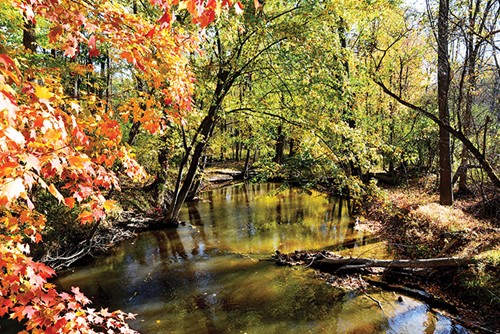What's the Issue?
When landscaping your yard you can protect your kids, pets, and the environment from harm. By choosing plants that are native to Michigan and by practicing good lawn-care practices, you can help prevent pollution of our lakes and streams.
Remember, a few simple changes can make a big difference!
Mow High. Make your lawn cheaper and easier to maintain by mowing high (three inches). Taller grass requires less water, promotes root growth, and shades out weeds.
Use Mulch. Place a thick layer of mulch (four inches) around trees and plants. This helps retain water, reduce weeds, and minimize the need for pesticides.
Go Native. Select plants native to Michigan. Native plants are better equipped to tolerate Michigan's climate, require less fertilizing, and are more disease resistant.
Variety is the Spice of Life. Using a wide variety of plants helps control pests and minimizes the need for pesticides.

Water Wisely. Generally, your lawn needs about an inch of water a week. Over-watering lawns results in shallow-rooted plants that are less tolerant of heat and drought, and more prone to disease. Avoid over-watering by using a rain gauge and watering only when necessary, instead of on a fixed schedule.
Use Less for Pests. Pesticides and herbicides can be harmful to our kids, pets, and the environment. So, use pesticides and herbicides sparingly. Limit applications to problem areas instead of applying to the entire area (e.g., weed and feed).
Rake It or Leave It. Follow the guidelines in your community for leaf pick-up. Never rake leaves into or near storm drains, ditches, or streams. Decaying leaves use up the water's oxygen, harming fish and the aquatic insects that fish depend on to survive. Best practice is to mow leaves into your lawn. Leaves and grass clippings are good fertilizers for your lawn.
Pick Up After Pets. Remember, pet waste left on the lawn can be washed into our waterways. Walk your dog in areas of vegetation and bury or flush pet wastes.
Give Your Lawn Some Air. Lawn aeration involves the removal of small soil plugs or cores out of the lawn and can increase your lawn’s ability to absorb water.
Keep Your Dirt. Stop soil erosion by planting vegetation in all bare areas.
Buffer. Create buffers of plants between waterways and hard surface areas to help filter out pollutants.
Keep your rainwater where it belongs…on your property.
Utilize Gutter Water. Direct water from roof drains and gutters to vegetated areas on your property.
Get a Rain Barrel. Install a rain barrel to collect roof runoff. Use it to slowly soak your landscape or water your flowers. A simple online search through Google or another search engine will bring up information on rain barrels, both purchasing pre-made ones and directions on how to make your own.
Plant a Tree. Use trees, shrubs, and other deep-rooted plants to hold and use water properly on your property.

Mow Less. Reduce the amount of lawn by adding berms, flowers, herbs, native plants, decorative grass, vegetable, and rain gardens.
Plant a Rain Garden. A rain garden is a place landscaped in your yard meant to help capture stormwater runoff and increase water absorption into the soil.
Use Porous Surfaces. Minimize use of concrete or asphalt by substituting gravel, paving stones, turf stones, or porous pavement.
